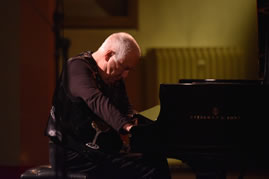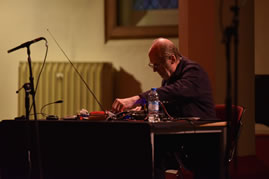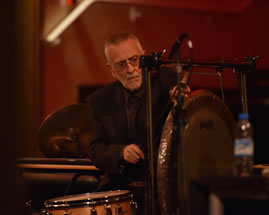

|
Moment's Notice Reviews of Recent Recordings AMM
 ©Brian Slater Writing about An Unintended Legacy, by AMM is a bit of a daunting task. Since 1965, the group has charted a singular approach to group improvisation, morphing through various ensemble configurations and releasing 30 recordings along the way. Right from AMMMusic, their 1967 debut on disc, AMM pushed forward a new way of thinking about collective playing based on a “collation of a set of minds.” The original liner notes posited 13 aphorisms that prodded at ways of thinking about group interaction, sound making, and perceptions about improvisation (the first prefaces this text; the other 12 appear throughout). Throughout their history, the group weathered the comings and goings of members, from an initial quartet of Lou Gare, Keith Rowe, Eddie Prévost, and Lawrence Sheaff down to duos, and eventually settling in on the trio of Rowe, Prévost, and pianist John Tilbury which lasted from 1982 to 2004, a configuration that produced some of their most indelible work. For an insightful history of the group, check out Stuart Broomer’s Ezz-thetics column in the September 2015 issue of PoD. But Cornelius Cardew’s description of his activity with AMM in An Unintended Legacy, a 3-CD set and accompanying book, documents three concerts the reconvened trio of Eddie Prévost, John Tilbury, and Keith Rowe performed in 2015 and 2016, a full fifty years after the group first came together. Rowe had left the group in 2004 and it seemed for many years that the split was permanent. But in 2015, the Huddersfield Contemporary Music Festival convinced the trio to get together to celebrate the fiftieth anniversary of the group; the first time that Rowe had played with the group in over a decade. At the time, many wondered if that performance was going to be a one-off, but four more performances followed, including the sets and Café OTO in London, the Sonic Protest Festival in Paris, and the Cornelius Cardew – From Scratch Festival in Trondheim, included in this set. II. An AMM performance has no beginning or ending. Sounds outside the performance are distinguished from it only by individual sensibility.  The improvisation flows in waves, building density and then opening up in to pools of abraded metallic textures, poised reverberating piano notes, and scoured electronic timbres. At about 20 minutes in, the three coalesce around the slow beating of tuned gongs, sine-like wafts of feedback, and damped, repeated low-end notes on the piano and they let that sit, slowly transforming the moment through the introduction of fragile phrases, crackled electronics, and resonating gong. Rowe weaves snippets of the Beach Boys song “Don’t Cry” in and the saccharine harmonies peak in and out, subverting Prévost’s bowed squall and Tilbury’s mounting piano lines. But that notion of assimilation comes through as the piece weaves its way to a quiet, somewhat unsettled conclusion. VI. The past always seems intentional, but at the time it appears to be accidental. The second disc, recorded in Paris on April 7, 2016 four months after the OTO show, begins with a sharp crack which seems to chart a more open strategy of interplay for the improvisation. The three lead in to the improvisation with an austere transparency, letting each sound resonate in the space. The notion of “feeling sounds in a completely different way than usual” is still a paramount driving force, even after fifty years of playing together, as frayed crunches, poised piano notes, and burnished percussion accrue. When Rowe floats in specters of Baroque chamber music, it lends a certain stateliness. For most of this meeting, the improvisation never rises to peaks and densities, instead proceeding with a certain restraint. In his essay included in the set, Keith Rowe states that “from the start, uselessness and failure were terms attached to our efforts, and we had better get used to it … Like the foetid tree and all other trees, we improvised our growth in the space allotted.” The declared tenet that “no guarantee that the ultimate realization can exist” has been fundamental to the group. This performance shows the three still committed to grappling with and ultimately embracing that foundational strategy. IX. To play and arrive at the state where you no longer need to play.  XII. Mistakes in and towards AMM could be due to constant references to sets of standards. In his introductory essay, Prévost says, “Given that our musical approach and collective purpose has survived this long it should not be surprising if focus is on the past. I would argue however, that as our musical approach is characterized and motivated by open enquiry, then there is always a forward momentum. It just might not be quite as fast as it once was.” Rowe continues in his essay that “One of the many characteristics of a tree in Cardew’s Tiger’s Mind is ‘A dead tree may remain standing for centuries after death.’ AMM had remained standing through storms, wind, flooding, quakes, drought, subsidence, the cold and heat, had limbs torn off, but still stand.” Many groups don’t last for 5 years, fewer still make it to 20. The fact that AMM, in its various and mutable guises has lasted for fifty is remarkable in itself. That Rowe, Prévost, and Tilbury agreed to put differences behind and meet up for the music captured here is even more noteworthy. There is little doubt that when the original members of AMM came together, there was no notion that they would be still be working together five decades later, let alone charting their music along the same tenets they laid forth in the notes of their initial release. Their history together, including this set, is indeed “An Unintended Legacy.” |